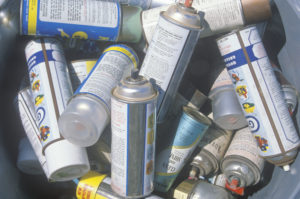2020 Federal Resource Conservation and Recovery Act (RCRA) Update

Waste Aerosol Cans
The EPA has added hazardous waste aerosol cans to the list of substances regulated as a universal waste under the Federal Resource Conservation and Recovery Act (RCRA). The rule, as published on December 9, 2019, will take effect on February 7, 2020.
EPA’s Universal Waste Regulations Streamline Hazardous Waste Management Standards
With the new rule, the storage and labeling requirements for waste aerosol cans are now largely the same as they currently are for batteries, bulbs, pesticides and other mercury-containing equipment. The EPA defines an aerosol can as “a non-refillable receptacle containing a gas compressed, liquefied or dissolved under pressure, the sole purpose of which is to expel a liquid, paste, or powder and fitted with a self-closing release device allowing the contents to be ejected by the gas.” Leaking and damaged aerosol cans may also be managed as universal waste, so long as the leaking or damaged cans are packaged in a separate closed container, overpacked with absorbents, or immediately punctured and drained.
Waste Storage
The waste must be accumulated in containers in good condition (structurally sound, no signs of leaks/spills/damage) and away from sources of heat. The containers must be appropriately labeled with the words “Universal Waste – Aerosol Cans”, “Waste Aerosol Cans”, or “Used Aerosol Cans”.
If a facility chooses to puncture and drain aerosol cans, the empty cans may be recycled. The following steps must be followed:
- Puncturing and draining activities must be conducted using a device specifically designed to do this safely and which will contain the residual contents and emissions effectively
- Establish and follow a written procedure discussing how to safely puncture/drain cans (including proper assembly, operation and maintenance of the unit, segregation of incompatible wastes, and proper waste management practices to prevent fires or releases); maintain a copy of the manufacturer’s specification and instruction on site; and train employees on the proper procedures of use
- Puncturing must be done in such a way to prevent fires and releases of any component of the waste to the environment (includes locating the equipment on a flat solid surface in a well ventilated area)
- The contents of the can must immediately be transferred to an adequate storage container
- Hazardous waste determination of the contents must be conducted, and if the waste is determined to be hazardous, it must be treated as such
- A written procedure must be in place in the event of a spill or leak and a spill kit must be stored nearby
Facilities that generate universal waste or that receive, accumulate and send universal waste may store hazardous waste aerosol cans for up to one year and ship hazardous waste aerosol cans without a manifest.
Check your State Regulations
As a reminder, these are federal regulations. Facilities should check appropriate state regulations before making changes in the management of waste aerosol cans.
Ask the Expert
For more information about the management of waste aerosol cans or any other hazardous waste and environmental compliance matters, please contact Katie Cirone, PE, Environmental Compliance Specialist.